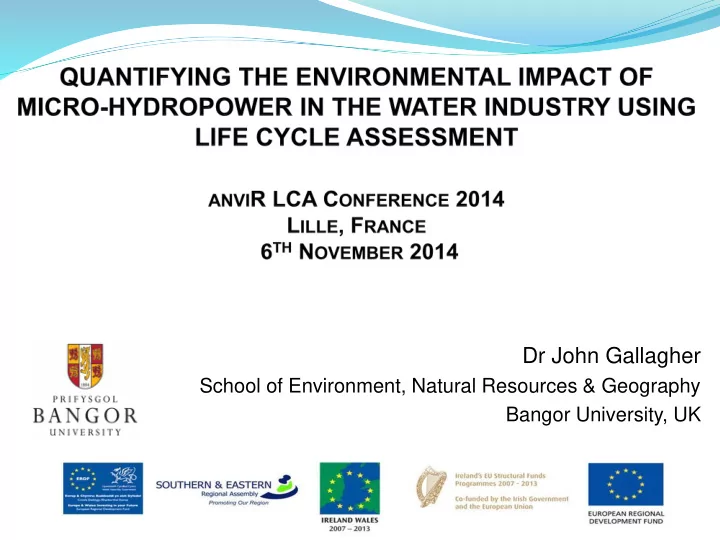

Dr John Gallagher School of Environment, Natural Resources & Geography Bangor University, UK
P RESENTATION OUTLINE • I NTRODUCTION TO H YDRO -BPT • LCA OF MICRO - HYDROPOWER • R ESULTS & D ISCUSSION • S UMMARY OF C ONCLUSIONS • F UTURE DIRECTIONS
E NERGY RECOVERY IN WATER & WASTEWATER INFRASTRUCTURE 2. Break Pressure Tank 1. Reservoir & Water Works e.g. Dublin, 90 kW, € 75k p.a. 4. Wastewater Outfall e.g. Yorkshire, 180 kW, £127k p.a. 3. Pressure Reducing Valve
E NGINEERING E NVIRONMENT I NVESTIGATING THE TECHNICAL A SSESSING THE E NVIRONMENTAL FEASIBILITY OF E NERGY R ECOVERY I MPACTS OF THE T ECHNOLOGY : L IFE IN THE W ATER I NDUSTRY USING C YCLE A SSESSMENT , C ARBON M ICRO - HYDROPOWER (MHP) F OOTPRINTING . GIS M APPING C OLLABORATION D EVELOPMENT OF A B USINESS / C REATING OF A GIS D ATABASE OF C OLLABORATION M ODEL FOR THE W ATER I NFRASTRUCTURE AND ITS I MPLEMENTATION OF E NERGY E NERGY R ECOVERY P OTENTIAL FOR R ECOVERY BY I NDUSTRY THE I RELAND -W ALES REGION . S TAKEHOLDERS IN PRACTICE .
LCA OF M ICRO - HYDROPOWER Q UANTIFYING THE ENVIRONMENTAL IMPACT OF M ICRO - HYDROPOWER IN THE WATER INDUSTRY USING LIFE CYCLE ASSESSMENT
O BJECTIVES Quantify the environmental impacts of three micro-hydropower (MHP) installations in water infrastructure Identify key differences between materials use and construction practices for these projects Determine the carbon payback of the MHP installations and compare to economic payback
15 kW 90 kW 140 kW Pen y Cefn Vartry Reservoir & Strata Florida Water Treatment Works Water Treatment Works Water Treatment Works Location: Gwynedd, Wales Location: Wicklow, Ireland Location: Ceredigion, Wales Dŵr Cymru Welsh Water Dublin City Council Dŵr Cymru Welsh Water Design capacity: 15 kW Design capacity: 90 kW Design capacity: 140 kW Power output: 12.5 kW Power output: 78 kW Power output: 110 kW Turbine: Zeropex Difgen Turbine: Kaplan Turbine: Pelton twin jet Head: 90-105 m Head: 7-16 m Head: 183-195.5 m Flow: 10-30 l/s Flow: 580-1200 l/s Flow: 100 l/s Existing housing in place Concrete housing constructed GRP kiosk constructed Gravity fed by Llyn Cynwch Gravity fed from nearby Vartry Fed by Llyn Teifi and Llyn reservoir reservoir Egnant raw water reservoirs New installation, flow control Replacing outdated Pelton New installation, existing DAF from Difgen turbine to DAF wheel turbine which generated system on site, 250-300 kW electricity for site since 1940’s treatments system energy consumption on site
R ESULTS – E NVIRONMENTAL BURDENS Normalised life cycle environmental burdens for MHP electricity 1. were lower for most categories assessed – Table – Life Cycle Assessment Impact Categories 2008). Impact Category Abbrev Units GHG Global Warming kg CO ₂ eq. GWP ef Potential w P Abiotic Resource ARD kg Sb eq. h Depletion as a I Acidification kg SO ₂ eq. AP s Potential ( S Human Toxicity kg 1,4-DCBe HTP USES eq. Potential s Figure – Normalised impact category contributions for MHP installations Dep Fossil Resource FRD kg kJ eq. compared with marginal grid electricity generation (300MW gas Depletion elec combined cycle plant).
R ESULTS – C OMPONENT BREAKDOWN Variability in construction practices and material use was evident in 2. range of global warming potential results of 2.14-4.36 g CO 2 eq./kWh Figure – Breakdown of environmental impacts of MHP case studies expressed per kWh generated over project 30-year lifespan (solid = constant, hatched = variable)
R ESULTS – C ARBON PAYBACK Carbon payback times for MHP installations ranged from 0.16 to 0.31 3. years (extending to 0.19 to 0.40 years during sensitivity analysis) Table – Total environmental impacts of MHP projects for different impact categories and carbon payback time (expressed per kWh generated over project 30-year lifespan). Impact categories Carbon Case GWP ARDP AP HTP FRDP payback study (g CO 2 ) (g Sb) (g SO 2 ) (g 1,4DCBe) (MJ) (years) 10 kW 2.14 1.4E-04 4.0E-02 10.05 2.7E-02 0.16 90 kW 4.36 1.1E-04 4.3E-02 9.17 1.1E-01 0.31 140 kW 2.78 9.4E-05 3.3E-02 8.91 6.1E-02 0.21 Expressed per kWh generated over project 30-year lifespan Carbon payback ~10% of financial payback
S UMMARY An environmental and sustainable design approach to MHP projects could reduce the environmental impacts of the technology Environmental impact of MHP (per kWh electricity over nominal project lifespan). Global warming potential of 2.14 – 4.36 g CO 2 eq/kWh The carbon payback was estimated to be from 0.16 to 0.31 years Turbine/generator are consistent components; larger carbon footprint with smaller installation per kWh capacity material selection impacts upon footprint vs project lifespan
F UTURE DIRECTIONS The carbon intensity of marginal grid electricity will increase in the future, the estimated carbon payback time will increase by 1% annually Table – Mitigation forecasting for total GHG emissions offset by MHP installations between 2015 and 2050 (displacements of CO 2 emissions associated with gas power plant). Cumulative GHG emissions (t CO 2 eq.) MHP installation 1 2015 2 2014 2025 2045 2050 -7 36 450 1,206 1,379 10 kW 90 kW -86 173 2,658 7,191 8,233 140 kW -80 300 3,944 10,592 12,121 1 Assuming MHP installations constructed by the end of 2014. 2 Signifies GHG emissions produced over the 30-year lifespan. Downward trend of GHG associated with marginal electricity generation
F UTURE DIRECTIONS Installation of MHP by the water industry can provide a 2% reduction to GHG emissions associated with water supply and treatment MHP for energy recovery in water infrastructure can generate ~18 GWh of electricity in Ireland and Wales The installations would add 1,700 t CO 2 eq. to the footprint of the industry Carbon payback Offset approximately 5,750 t CO 2 eq. per year 2% reduction (20 g CO 2 eq. per m 3 of water) in the GHG emissions associated with water supply and treatment (~1 kg CO 2 per m 3 , (Defra, 2012))
Recommend
More recommend